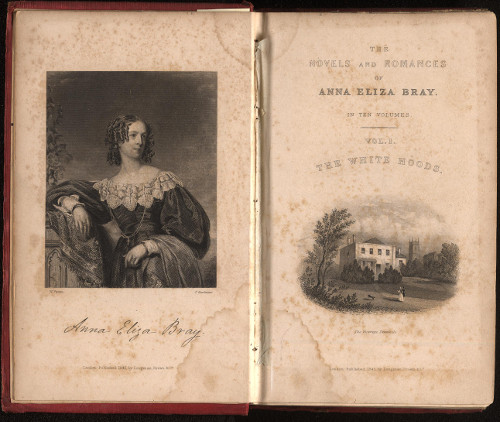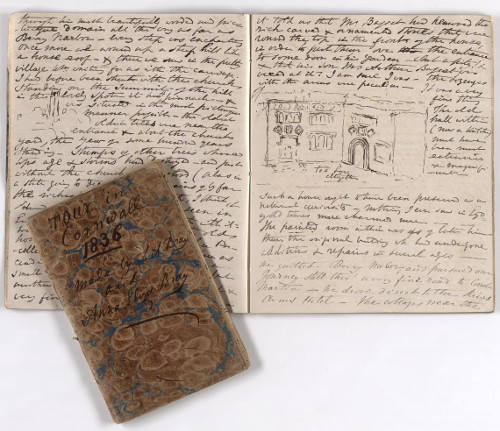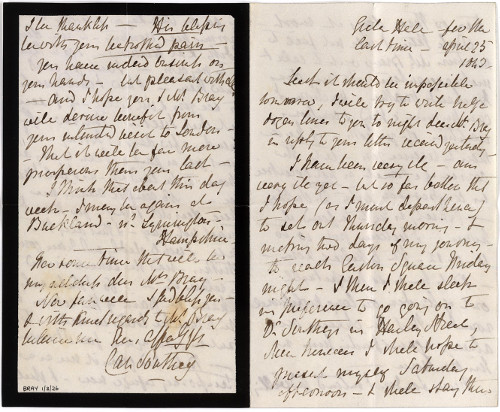Archives Hub feature for November 2015
The papers of 19th Century author Anna Eliza Bray (1790-1883) have recently been catalogued at West Sussex Record Office and are now available for researchers to access. The catalogue can be viewed via our Search Online facility at http://www.westsussexpast.org.uk/searchonline/.

Anna Eliza Bray (formerly Stothard, neé Kempe) was born on 25th December 1790 in Newington, Surrey, the daughter of Alfred Kempe and Ann Arrow, and sister of the antiquary Alfred John Kempe. She was originally destined for a career in the theatre but this endeavour was cut short as she fell ill days before her first performance at Bath’s Theatre Royal in May 1815, and she subsequently lost the opportunity to appear on the stage again.
In February 1818, she married Charles Alfred Stothard, an antiquarian draughtsman whom she had met a number of years before through his father, the Royal Academy artist Thomas Stothard. She travelled to France with her husband in 1820 for his work, and afterwards published her first book ‘Letters written during a tour of Normandy’. This established her as a writer and enabled her to progress into the literary circles of her day, which included notable figures such as Sir Walter Scott, John Murray, Amelia Opie, Letitia Elizabeth Landon and (the most influential character in her career) Robert Southey, who was Poet Laureate from 1813-1843. However, her husband died shortly afterwards in a tragic accident on 28th May 1821, when he fell from a ladder in Bere Ferrers Church in Devon while drawing the stained glass window.
In late 1822, she married Reverend Edward Atkyns Bray and moved to Tavistock in Devon. The West Country was a significant influence on her writing and it was during this period that most of her literary output was produced, including her best-known work ‘A Description of the part of Devonshire bordering on the Tamar and the Tavy’, published by John Murray in 1836. Other works included a 10-volume set of historical novels, another travel book entitled ‘Mountains and Lakes of Switzerland’ and a children’s book entitled ‘A Peep at the Pixies’.

After her husband’s death in 1857, Mrs Bray moved back to London and continued to write well into the 1870s, editing and publishing her late husband’s sermons and writing further books on French history and Devon folklore. In the last few years of her life, she was briefly back in the public eye again, after being accused of stealing a small part of the Bayeux Tapestry on her trip to France almost 60 years before. Fortunately, the publication of an article in the Times written by her nephew subsequently cleared her name. She died on 21st January 1883 at the age of 92.
The archive was presented to West Sussex Record Office in November 2000 by a member of the Kempe family, the present day descendants of Anna Eliza Bray. Later members of the Kempe family also have their archives housed at the Record Office, including Mrs Bray’s great nephew, the mathematician Sir Alfred Bray Kempe.
In terms of size, the archive is a very small one but the saying ‘quality over quantity’ certainly applies here, as it spans nearly 70 years of the late Regency and Victorian period. It has been catalogued into four series: correspondence, manuscripts, printed books and miscellaneous.
The correspondence has been sub-divided into the main families represented in the collection: Landon, Southey, Warter and Kempe as well as an additional section for miscellaneous letters.
The manuscripts are handwritten journals and drafts; most of the works are by Mrs Bray, but also include drafts of works she has copied from books of other authors such as Amelia Opie and a handwritten poetry book dating from the early 1820s belonging to Mary Maria Colling, an amateur poet from Tavistock. Mrs Bray, with assistance from Robert Southey, published a selection of Colling’s poetry on her behalf in 1831 entitled ‘Fables and Other Pieces in Verse’. Mrs Bray’s autobiography, published posthumously in 1884, forms a significant part of the draft papers. The archive includes a printed copy and a 3-volume draft manuscript of the autobiography which have been immensely helpful in revealing a great deal more about her life; parts of it have also been used to make sense of other documents in the archive.
Printed books are her publications; although not all are included in the archive, there is a good selection of her work represented, such as her biography of the artist Thomas Stothard.
Miscellaneous items include a scrapbook of watercolours, locks of hair belonging to Robert and Caroline Southey and a piece of mourning stationary signed by Prime Minister Benjamin Disraeli in the latter part of the 19th Century.
The archive also contains over 100 letters from Caroline Southey, the second wife of Robert Southey, with whom Mrs Bray was first acquainted in 1840. Regular correspondence continued until Mrs Southey’s death in 1854, and letters in the archive mention notable figures including William Wordsworth and members of the Coleridge family. There is also ‘Mrs Southey’s Narrative’, a biographical piece written by Caroline Southey in 1840 regarding her courtship and marriage to Robert Southey, copied by Mrs Bray’s niece from the original manuscript.

I will be presenting a talk on the Bray archive at West Sussex Record Office in Chichester entitled ‘A Peep at the Pixies’: exploring the life and literary archive of Anna Eliza Bray (1790-1883) on Tuesday 24th November 2015 at 7pm. Tickets cost £7.50 including refreshments, and a selection of documents from the archive will be out on display. Places must be booked in advance by contacting our reception on 01243 753602.
For any enquiries regarding the collection, catalogue or the November talk please contact West Sussex Record Office by emailing records.office@westsussex.gov.uk.
Holly Wright
Searchroom Assistant, West Sussex Record Office
Related
Papers of Anna Eliza Bray (1790-1883) on the Archives Hub:
https://archiveshub.jisc.ac.uk/data/gb812-bray
Browse other collections of West Sussex Record Office on the Archives Hub.
All images are reproduced with the permission of West Sussex Record Office
